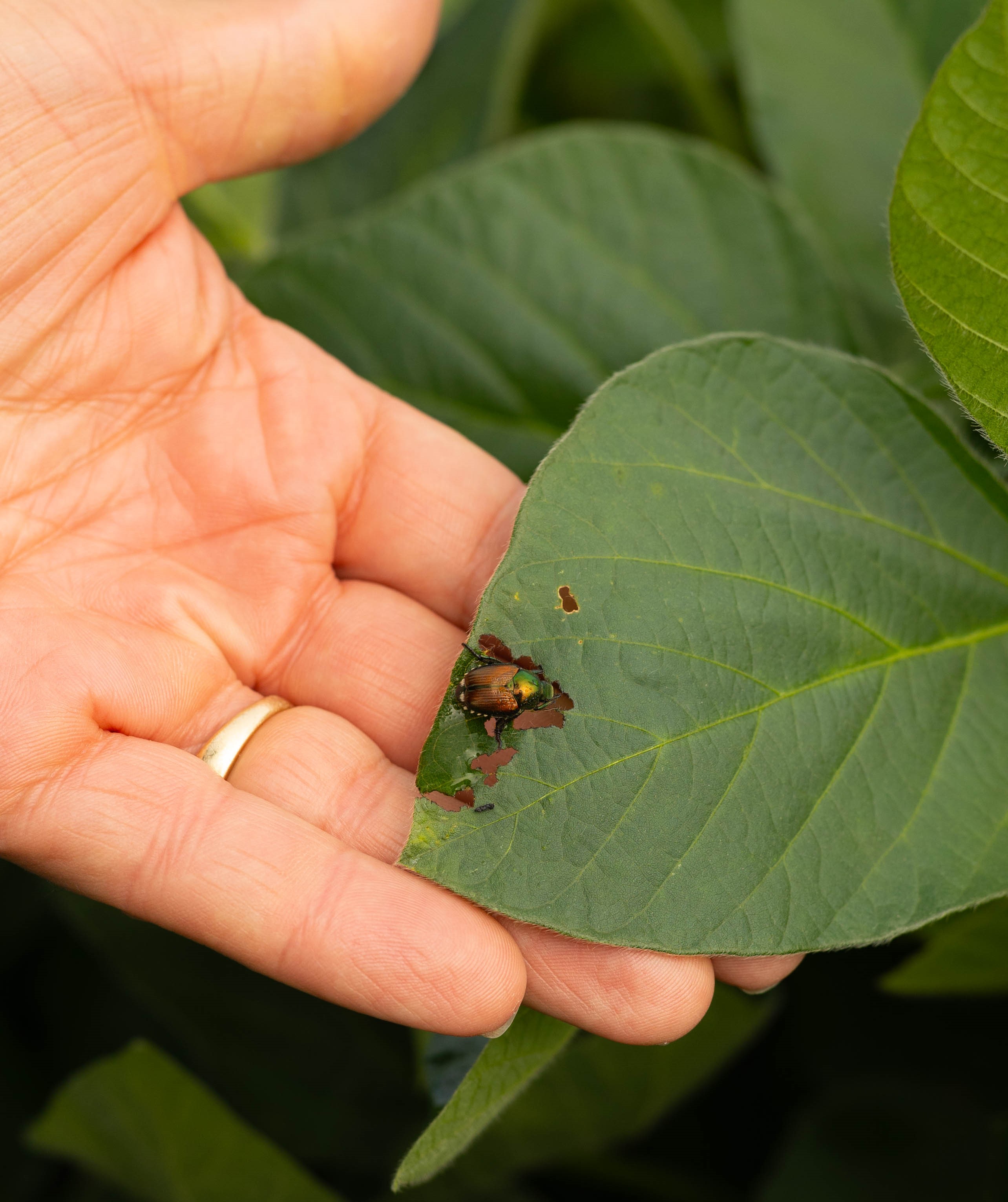
Research agronomists Lucas De Bruin, Drew Clemmensen and Shane Beck. (Photo: Iowa Soybean Association / Joclyn Bushman)
Walking Rows: ISA agronomists update – July 3
July 3, 2024 | Kriss Nelson
For most of the crops in the state, post-emergent herbicide applications have been completed. Iowa Soybean Association (ISA) research agronomists are advising farmers to remain vigilant about disease and to consider timely fungicide applications, given the weather conditions.
Drew Clemmensen – Northwest/Western Iowa
Soybeans range from V3 to R1 growth stages and look good in the areas where I have traveled. If we stay cooler with the rains we have been getting, white mold becomes a concern.
Use caution when scouting fields as dying plants typical of white mold could also be soybean gall midge moving into fields. Both are difficult to control, so confident scouting is needed to create a plan of action in controlling or suppressing each.

Waterhemp escapes are greater this year than in years past. Just because the second pass of herbicide is down on these acres doesn't mean your weed control is 100% effective, be watching historically high weed pressure areas, old building/cattle lot sites, waterways, and field edges for escapes as a rescue treatment now while weeds are relatively small will have a greater chance of success of control than waiting to see weeds emerged above the crop canopy.
Early planted corn is quickly reaching the VT stages of development. With daytime temperatures around 85 degrees combined with extended humid to damp conditions in the canopy, we are creating optimum conditions for diseases. Be scouting now as most research indicates VT as the optimum time to apply a fungicide. If you are planning to make an application before the VT timing, remember to leave the surfactant out of the tank mix to avoid injury to the developing ear.
Lucas DeBruin – Southeast/Eastern Iowa
The soybeans and corn in my districts are in good condition. The beans have reached the R1 stage, so it's important to follow the post-emergence spray labels as some herbicides become off-label at the soybean’s reproductive stage.
Farmers should continue scouting as there is ample moisture, which can kickstart diseases. Some cornfields are showing signs of gray leaf spot. To identify this disease, look at the lower leaves of the corn plant for gray, interveinal lesions. Tar spot is also a concern in corn.

Japanese beetles could attack both corn and soybean fields. Corn rootworm and bean leaf beetles are other insects to be aware of now that we are into July. If the rain stops, soybean aphids and spider mites could appear.
It's harvest time for small grains such as wheat and rye. I am anticipating the harvest of rye in some of our relay cropping trials soon.
Mikaela Lawrence – Southwestern/Southern Iowa
Soybean growth is ranging from R1 to V3 and the early planted corn has now reached the VT growth stage with the later planted fields at V5 to V6. Some of the earlier planted corn is started to tassel in southwest and central areas of the state.

I have found Japanese beetles in fields, most recently in Adair County, and stink bugs in Taylor County. Soybean Gall Midge is still being found in the western part of the state and could continue to move east, affecting new areas.
 Japanese beetle
Japanese beetle
Most farmers are finishing up their post-emergence herbicide applications. If you are discovering your herbicide was not as effective this year, I would encourage you to think about adding different modes of action to avoid using the same herbicide year after year.
Shane Beck – Northeast/Northern Iowa
The corn and soybeans have grown a lot in my area over the last two weeks. With that rapid growth, I have noticed there has been some IDC (iron deficiency chlorosis) showing up in some of the low spots in soybean fields. Symptoms of IDC are yellow leaves on the new growth of leaves since iron is not mobile in plants. IDC is not caused by a lack of iron in the soil, it is caused by the plants inability to metabolize and uptake the nutrient. This is why it is very common in the low areas where soils are wet and there is not a lot of oxygen for the roots to breathe and absorb nutrients. Generally, the soybeans will grow out of it relatively quickly as long as the ground is not saturated. It looks like many of the areas I saw with IDC are already starting to grow out of it.

With the storms last week, there was some corn that was blown over or had a severe lean to it. Nothing that I saw snapped and it will gooseneck back up in the next few days. This can cause some lodging when harvest rolls around, making harvest a bit more challenging. As the season progresses and more storms continue to impact areas, watch for corn that may be green snapped by the wind. If it snaps above the ear and there is still sufficient plants with pollen there should be an ear produced.
Back